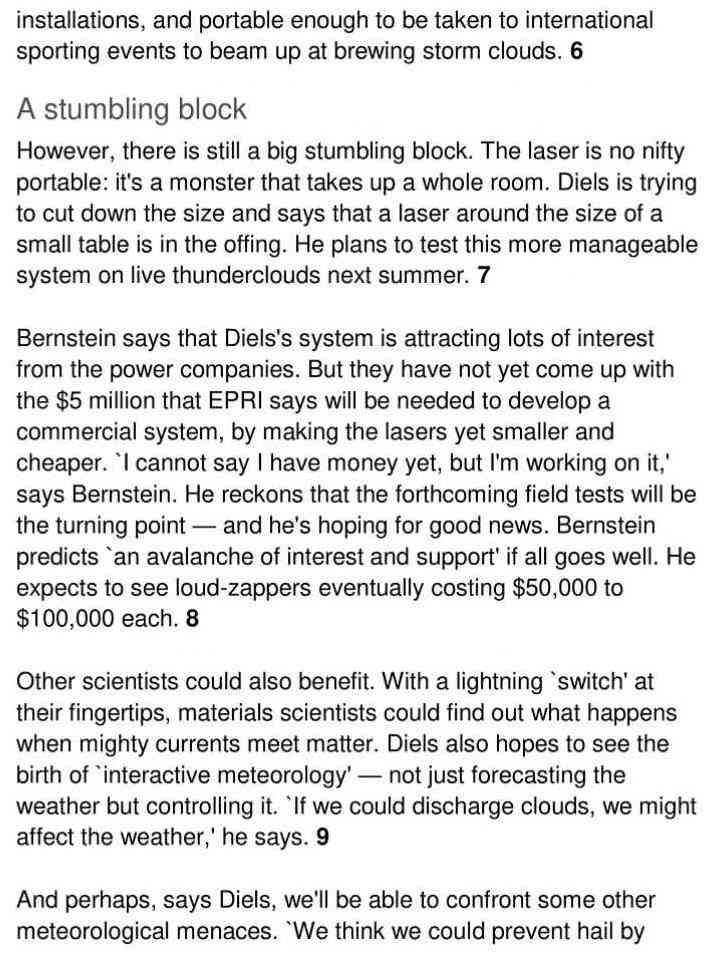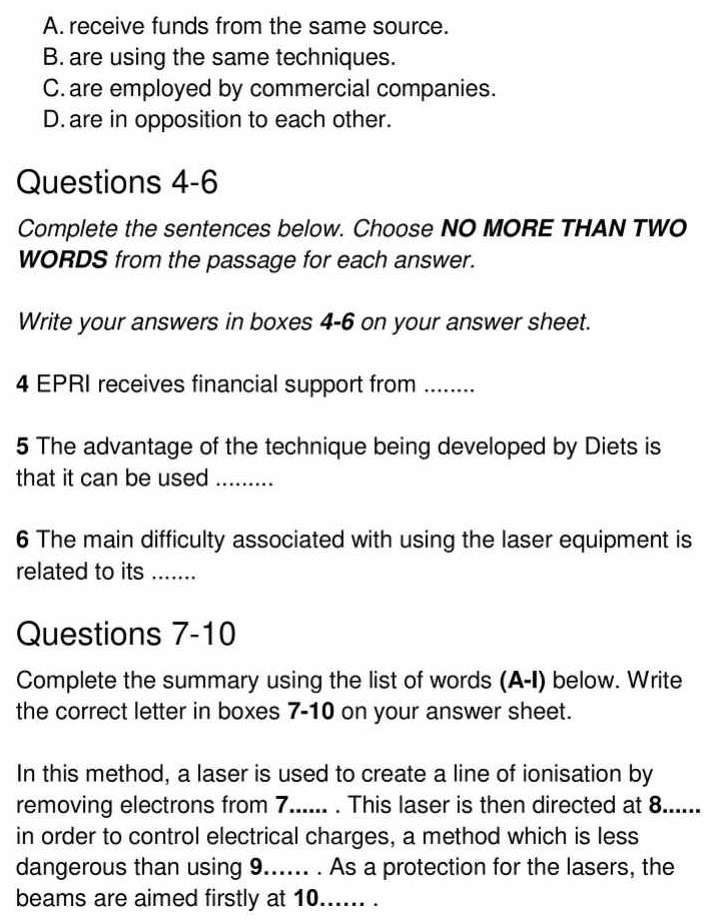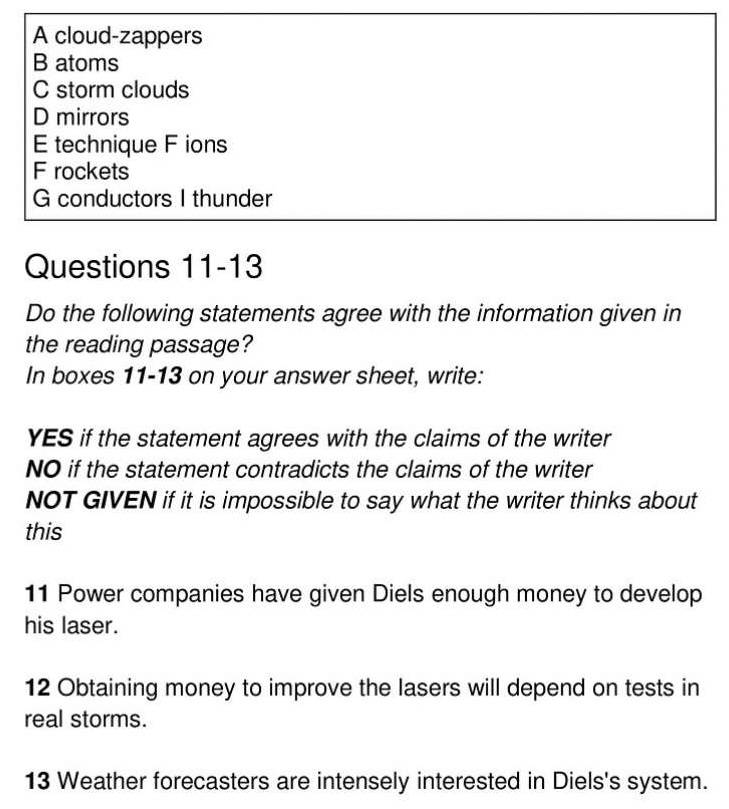Striking Back at Lightning with Lasers Reading Answers
8 min read
Updated On
-
Copy link
Table of Contents

Limited-Time Offer : Access a FREE 10-Day IELTS Study Plan!
The Academic passage ‘Striking Back at Lightning with Lasers’ is a reading passage that appeared in an IELTS Test. Try to find the answers to get an idea of the difficulty level of the passages in the actual reading test. If you want more passages to solve, try taking one of our IELTS reading practice tests.
The question types found in this passage are:
Multiple Choice Questions
The Multiple Choice Questions require you to select the correct answer from a list of options. There are various numbers of answer options, but test takers can usually expect to choose from three or four options, all of which are letters (A, B, C, or D). The type of question requires test takers to select one out of the four alternatives, but you may also have to select two answers from five possibilities or three responses from six options.
Sentence completion
In sentence completion, you’ll be asked to fill in the blank spaces using the words given in the text. It is important to pay close attention to the instructions that are given in the question because in some instructions there will be a word limit mentioned and you may lose marks if you don’t follow it.
Summary Completion
In the summary completion type of question, you will be provided with a summary of information from a text, and there will be a few gaps. You will either get a list of words to be filled in the gaps or you could be asked to find answers from the reading passage. You will have to insert a few words from the text into the gaps. All of the information in the summary will also be available in the reading text. However, they will be using paraphrasing and synonyms. Thus, you cannot expect to find the exact words.
Yes/No/Not Given Questions
Similar to the True/False/Not given questions, Yes/No/Not given questions also have various statements. But here you are asked to agree or disagree with the statement based on the opinion of the author.
Striking Back at Lightning with Lasers






Answers
Unlock Answers
1 Answer: D
Question Type: Multiple Choice Questions
Answer location: Paragraph 2, line 2
Answer explanation: In paragraph 2, we get to know how there are tested strategies for ‘neutralising’ (controlling) ‘the power of thunderstorms’, and they are equipped with an armoury of ‘lasers’ that they will be pointing towards the heavens to discharge thunderclouds before lightning can strike. In the remaining paragraphs, this technique is being discussed and various information related to the technique or research is provided. Other than this, there is no mention of the damage caused to US golf courses and golf players by lightning strikes, the effect of lightning on power supplies in the US and in Japan or a variety of methods used in trying to control lightning strikes. Hence, the answer is D (a laser technique used in trying to control lightning strikes).
2 Answer: A
Question Type: Multiple Choice Questions
Answer location: Paragraph 1, line 4
Answer explanation: Paragraph 1 relates that ‘when thunderstorms strike’, their electrical fury causes ‘damage to property’ (buildings) ‘each year’. Hence, the answer is A (does considerable damage to buildings during thunderstorms).
3 Answer: A
Question Type: Multiple Choice Questions
Answer location: Paragraph 3, line 3
Answer explanation: Paragraph 3 mentions that the technique of firing rockets trailing wires into thunderclouds survives to this day at a test site in Florida run by the ‘University of Florida’, with ‘support’ (funding) ‘from the Electrical Power Research Institute’ (EPRI), based in California. Furter, in paragraph 5, it is given that Jean-Claude Diels of the ‘University of New Mexico’ is leading a project, which is ‘backed by EPRI’, to try to use lasers to discharge lightning safely. Therefore, both the universities are backed by the same source, EPRI. Hence, the answer is A (receive funds from the same source).
4 Answer: power companies
Question Type: Sentence Completion
Answer location: Paragraph 3, line 3
Answer explanation: Paragraph 3 states that ‘Electrical Power Research Institute (EPRI)’, based in California. EPRI, which is ‘funded by’ (receives financial support) ‘power companies, is looking at ways to protect the United States’ power grid from lightning strikes. Hence, the answer is ‘power companies’.
5 Answer: safely
Question Type: Sentence Completion
Answer location: Paragraph 5, line 2
Answer explanation: Paragraph 5 tells about a technique or project developed by Diels which is backed by EPRI, to try to use lasers to discharge lightning ‘safely’- and ‘safety is a basic requirement’ which is the advantage of the technique. Hence, the answer is ‘safely’.
6 Answer: size
Question Type: Sentence Completion
Answer location: Paragraph 7, line 3
Answer explanation: Paragraph 7 reveals that there is still a big stumbling block for the technique developed by Diels. The laser is so big that it is like ‘a monster that takes up a whole room’. ‘Diels is trying to cut down the size’ and says that a laser around the size of a small table is in the offing. Therefore, the difficulty is in the size of the laser, hence, the answer is ‘size’.
7 Answer: B
Question Type: Summary Completion
Answer location: Paragraph 6, line 1
Answer explanation: Paragraph 6 explains that high-powered lasers were revealing their ability to ‘extract’ (removing) ‘electrons out of atoms’ and ‘create ions’ (ionisation). If a laser could generate ‘a line of ionisation’ in the air all the way up to a storm cloud, this conducting path could be used. Hence, the answer is B (atoms).
8 Answer: C
Question Type: Summary Completion
Answer location: Paragraph 6, last line
Answer explanation: Paragraph 6 points out that if ‘a laser’ could generate a line of ionisation in the air ‘all the way up to’ (directed) a ‘storm cloud’, this conducting path could be used to guide lightning to Earth, before the electric field becomes strong enough to break down the air in an uncontrollable surge, that is, the electrical charges should be in control. Hence, the answer is C (storm clouds)
9 Answer: G
Question Type: Summary Completion
Answer location: Paragraph 4, line 4
Answer explanation: In paragraph 4, the author lets out the fact that while ‘rockets’ are fine for research, they ‘cannot provide the protection’ from lightning strikes and asks who would want to fire streams of rockets in a populated area? in the beginning of the fifth paragraph. Later, in the fifth paragraph, he adds that Diels is leading a project, which is backed by EPRI, to try to ‘use lasers to discharge lightning safely’- and ‘safety is a basic requirement’. So, it proves that the method of using lasers is less dangerous than using rockets. Hence, the answer is G (rockets).
10 Answer: D
Question Type: Summary Completion
Answer location: Paragraph 6, line 3
Answer explanation: Paragraph 6 notes that to ‘stop the laser itself being struck’ (protection for the lasers), it would be ‘directed at’ (aimed at) ‘a mirror’ firstly, and from there into the sky. Hence, the answer is D (mirrors).
11 Answer: NO
Question Type: Yes/No/Not Given Question
Answer location: Paragraph 8, line 1
Answer explanation: It is given in paragraph 8 that the power companies ‘have not yet come up with the $5 million’ that EPRI says will be needed to develop a commercial system, by making the lasers yet smaller and cheaper. So, it means that they have not given Diels enough money to develop his laser. Hence, the answer is ‘NO’ as the statement contradicts the claims of the writer.
12 Answer: YES
Question Type: Yes/No/Not Given Question
Answer location: Paragraph 8, line 3
Answer explanation: Paragraph 8 introduces that Bernstein reckons that the forthcoming ‘field tests’ (tests in real storms) ‘will be the turning point’ – and he’s hoping for good news. He predicts ‘an avalanche of interest and support’ (funding/ money) if all goes well. Hence, the answer is ‘YES’ as the statement agrees with the claims of the writer.
13 Answer: NOT GIVEN
Question Type: Yes/No/Not Given Question
Answer location: Paragraph 9, line 3
Answer explanation: In paragraph 9, the author suggests that Diels hopes to see the birth of ‘interactive meteorology’ – not just forecasting the weather but controlling it. In paragraph 10, it is further mentioned that Diels said that they will be able to confront some other ‘meteorological menaces’. Other than these two references to meteorology, there is no mention whether weather forecasters are intensely interested in Diels’s system or not. Hence, the answer is ‘NOT GIVEN’.
Check More IELTS Reading Answers
| Nature Or Nurture Answers | The Coconut Palm Reading Answers |
| The Department Of Ethnography Reading Answers | The Lost City Reading Answers |
| Gifted Children Learning Answers | Making Every Drop Count Answers |
Also check :
Practice IELTS Reading based on question types

Start Preparing for IELTS: Get Your 10-Day Study Plan Today!
Recent Articles

Nehasri Ravishenbagam

Haniya Yashfeen

Haniya Yashfeen

Haniya Yashfeen




Post your Comments